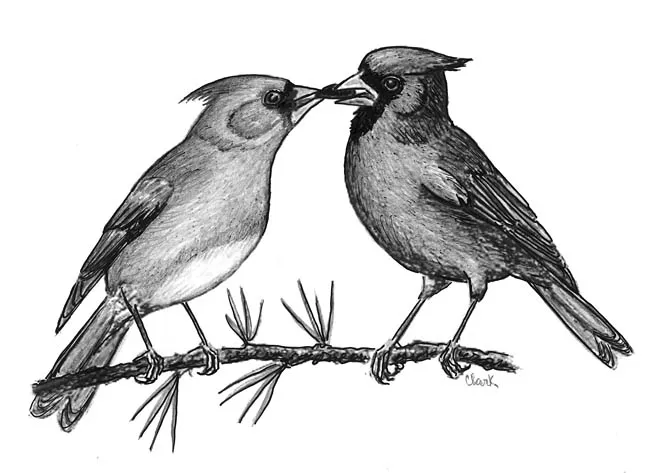Have you ever spotted a pair of vibrant Northern Cardinals in your yard, the bright red male gently touching beaks with the more subdued female? It looks just like a tender kiss, sparking wonder about whether these birds are expressing affection like humans. This behavior, often searched as “do cardinals kiss,” captivates backyard birdwatchers everywhere. But is it romance or something more practical? In this article, we’ll explore the science behind cardinal courtship, drawing from ornithological expertise to clarify what you’re really witnessing.
Northern Cardinals (Cardinalis cardinalis) are a beloved sight across North America, especially at feeders during winter blizzards or spring nesting season. Unlike many songbirds where males dominate the singing, both male and female cardinals belt out tunes, often in beautiful duets. This progressive partnership sets the stage for their unique courtship rituals, which prioritize pair bonding and survival over Hollywood-style romance.
The Science of Cardinal Courtship Behaviors
Cardinal pairs frequently stay together year-round in the same territory, making them appear as devoted couples. The male’s striking red plumage contrasts with the female’s olive tones—a trait called sexual dimorphism that ensures easy sex identification, unlike lookalike pairs in species like Mute Swans. During breeding season, typically late winter to early spring, the male ramps up displays to woo his mate.
Courtship involves singing to declare territory and alert to dangers, though researchers are still decoding exact “lyrics,” as noted by the Cornell Lab of Ornithology. Females match males note-for-note, turning neighborhoods into avian concerts. These duets strengthen bonds and coordinate activities, per studies in Birds of the World.
 Male Northern Cardinal feeding female during courtship, beak-to-beak
Male Northern Cardinal feeding female during courtship, beak-to-beak
This image captures the classic moment: the male offering food beak-to-beak. But rest assured, it’s not a smooch—it’s mate feeding, a widespread bird ritual.
What Is Mate Feeding and Why Do Cardinals Do It?
Mate feeding is when the male gathers seeds, insects, or fruits and passes them directly to the female. She signals readiness by quivering her wings like a hungry nestling, sometimes begging every 15 seconds. This isn’t just affection; it serves multiple purposes backed by research.
First, it fosters pair bonding, helping pairs synchronize before nesting. Females test males’ provisioning skills—crucial since she’ll incubate eggs while he forages. A study in Ethology (Jawor & Breitwisch, 2006) links male plumage brightness to feeding effort, suggesting females select reliable providers. DNA analyses from Wikipedia and Cornell reveal 9-35% of nestlings aren’t sired by the social mate, indicating extra-pair mating, but feeding still predicts good parenting.
During incubation, the male continues feeding so she stays on the nest, boosting chick survival. Both parents then feed fledglings insects for 25-56 days post-hatching. Cardinals’ strong beaks crack seeds efficiently, but young need protein-rich bugs.
If no food exchanges visibly, the male might simulate the motion to maintain interest, or tiny bits like seed husks go unnoticed. It’s practical evolution, not sentimentality.
Why Does It Look Like Kissing? Debunking the Romance Myth
Humans anthropomorphize this beak-touching as kissing because it’s our love language. But birds lack lips or hands—beak-to-beak is their only sharing method. Compare it to a wild turkey’s spasmodic strut: awkward to us, irresistible to turkeys.
Love as emotion is human-centric, per many scientists; bird behaviors are instinctive for reproduction. Yet, cardinals’ lifelong-ish pairing (they re-pair if widowed) fuels romantic tales. Films like March of the Penguins amplify this, but experts like those at All About Birds emphasize survival.
Cardinals aren’t unique—many species mate-feed, from shrikes gifting impaled prey to pigeons regurgitating crop milk.
Cardinal Pair Life: Monogamy, Singing, and Territory
Pairs defend year-round territories, with males chasing rivals (even reflections in windows). Females build nests in shrubs, laying 3-4 eggs per clutch, up to 4 broods yearly. They eat seeds, fruits, grains, and insects, thriving near feeders with black oil sunflower seeds.
Both sexes sing year-round, females rivaling males’ volume. This duet habit, rare in songbirds, aids communication.
Final Thoughts: Appreciating Cardinals’ Real Magic
So, do cardinals kiss? Not quite—it’s mate feeding for bonding, provisioning tests, and nest duty. This efficient behavior ensures thriving offspring, showcasing nature’s ingenuity over fairy-tale romance. Next time you see it, smile at their partnership.
Attract cardinals to your yard with platform feeders, native shrubs, and water sources. Observe ethically without disturbing nests. For personalized advice, consult local Audubon chapters or ornithologists.
References:
- Cornell Lab of Ornithology. “Northern Cardinal.” All About Birds. https://www.allaboutbirds.org/guide/Northern_Cardinal/overview
- Jawor, J.M., & Breitwisch, R. (2006). “Is mate provisioning predicted by ornamentation? A test with Northern Cardinals.” Ethology, 112(9), 888–895.
- Halkin, S.L., & Linville, S.U. (1999). “Northern Cardinal.” The Birds of North America.
- Wikipedia contributors. “Northern cardinal.” https://en.wikipedia.org/wiki/Northern_cardinal (accessed Nov 2025).
